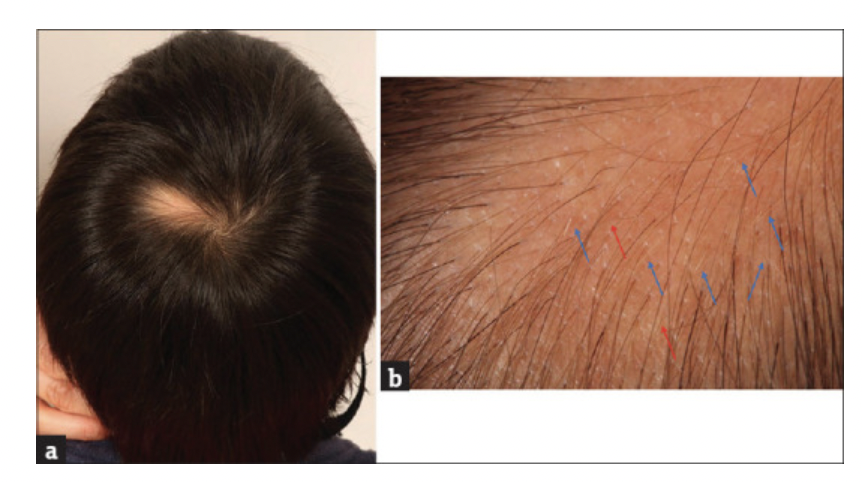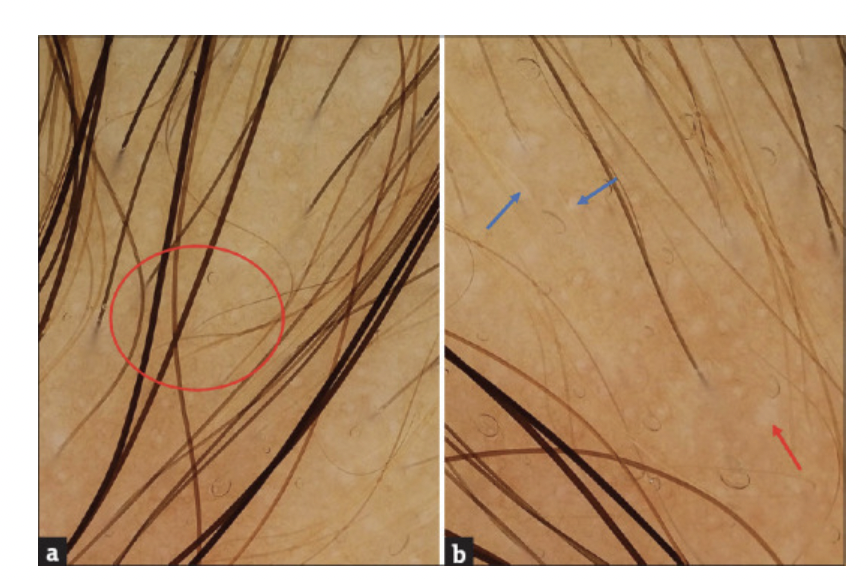Atypical Location of Congenital Triangular Alopecia
Another Example of Atypical Congenital Triangular Alopecia
Congenital Triangular Alopecia (CTA) is a type of localized hair loss that typically affects the temples. The condition develops in early childhood but may not be present immediately at birth. The key to the diagnosis is the finding of a patch of hair loss in the temples. The shape of the area of hair loss is usually triangular in nature and the pointy aspect of the triangle points upwards to the crown. Trichoscopy shows vellus hairs with no broken hairs or black dots to suggest alopecia areata. The area does not regrow over time.
In 2020, Starace et al reported a series of 78 patients with CTA. In 13 % of cases (10 of 78 patients), the location of hair loss was not the temples. In 5 patients, the CTA was located in the occipital area and in 4 patients it was the parietal area. The location for CTA was the vertex in 1 patient.
SEE: “Congenital Triangular Alopecia = 13 % of the Time It’s Not the Temples”
Shimrada K et al. 2022
A new report by Shimrada and colleagues describes another atypically located CTA in a patient with Down syndrome.
The patient in the report was a 4-year-old boy with Down syndrome who had a patch of non-scarring alopecia since birth. He was first diagnosed with alopecia areata (AA) although hair loss did not improve with topical application of corticosteroids. A triangular-shaped, non-scarring, and non-inflammatory patch of hair loss with accompanying vellus hairs was noted in the leftparietal scalp. Trichoscopy of the area showed white hairs, vellus hair surrounded by terminal hair, and empty follicles. The diagnosis reached was that of congenital triangular alopecia.
A triangular-shaped, non-scarring, and non-inflammatory patch of hair loss is seen in the vertex scalp. Close magnification shows white hairs and vellus hairs. SOURCE: Shimrada K et al. Atypical Localization of Congenital Triangular Alopecia Associated with Down's Syndrome. Indian J Dermatol. 2022 Jan-Feb; 67(1): 94. Used with creative commons license.
Trichoscopy findings of a 4 year old male with congenital triangular alopecia. White hairs and vellus hair and empty follicles are visible on trichoscopy. SOURCE: Shimrada K et al. Atypical Localization of Congenital Triangular Alopecia Associated with Down's Syndrome. Indian J Dermatol. 2022 Jan-Feb; 67(1): 94. Used with creative commons license.
Comment.
Many patients with CTA have no underlying genetic or medical issues. CTA has rarely been reported in association with some congenital disorders including Down syndrome. In fact, Yamazaki et al in 2010 described CTA to be rarely associated with such conditions as phakomatosis pigmentovascularis, Down syndrome and Dandy-Walker malformation
Shimrada K et al. Atypical Localization of Congenital Triangular Alopecia Associated with Down's Syndrome. Indian J Dermatol. 2022 Jan-Feb; 67(1): 94
Starace M et al. Atypical Presentation of Congenital Triangular Alopecia: A Case Series in Italy. Dermatol Pract Concept Oct 2020
Yamazaki et al. Temporal triangular alopecia and a review of 52 past cases. J Dermatol. 2010 Apr;37(4):360-2.
This article was written by Dr. Jeff Donovan, a Canadian and US board certified dermatologist specializing exclusively in hair loss.


